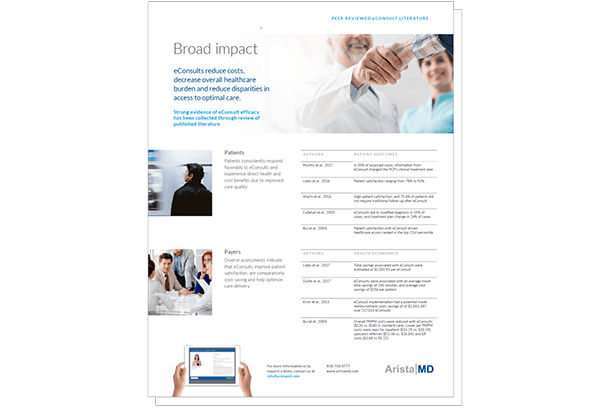Peer-reviewed eConsult Study – Efficacy and Outcomes
eConsults Deliver Proven Value to Payers, Providers and Patients
The AristaMD eConsult platform includes workup checklists and cloud-based platform access to board-certified specialists for eConsults, quantifiably supporting health care goals. Read more about the quantified value of eConsults through a summary of peer-reviewed literature.
eConsult Study
Extending Specialty Care in the Community
Through a partnership with AristaMD, Stanford Medicine has dramatically reduced wait times, improved access to sub-specialties, and created a path to faster resolution of clinical outcomes. By preserving the patient-physician relationship and instead empowering the community physician to do more for their patients. For Stanford faculty, reducing barriers to patients and thereby enriching their practice with a more diverse set of clinical cases has proven to be valuable.

eConsult study shows a reduction in patient wait times for referral
Featured in Electronic Health Reporter, Patient Safety and Quality Healthcare, and Inside Digital Health | By Brooke LeVasseur, CEO, AristaMD
Innovative healthcare solutions are invaluable when a practice is working to reduce patient wait times for referrals. As a result, telehealth solutions, such as eConsults, increase the efficiency of care by improving access to specialists while also better optimizing time and place of care.
The shortage of specialist physicians in the United States continues to receive a great deal of attention as an area of concern. However, a lesser-known compounding factor is the increase in referral rates. In a 2012 study, the National Ambulatory Medical Care Surveys found that between 1999 and 2009, the probability of receiving a specialist referral during an ambulatory patient visit increased from 4.8% to 9.3%, a 92% increase, nearly double.
While this study is now several years old, we can surmise that this trend has continued due to the persistence of several factors contributing to the overall disparity between specialist referrals and the number of available specialist physicians. The clear impact of these compounded problems is substantially increased wait times among patients with a physician referral for a specialist appointment.

